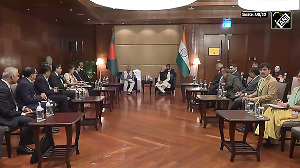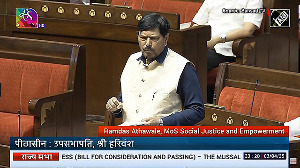The government is summoning banks to review their lending and investment practices over the past six months because it believes the fiscal stimulus is not making an impact owing to the inadequate availability of bank finance to industry.
Cabinet Secretary K M Chandrasekhar was initially scheduled to meet bankers and industry leaders on March 27, but the meeting has been deferred to April, owing to election pressures.
While some private and foreign banks may also be called for the meeting, a public sector bank chairman saw the move as another message from the government to pare lending rates.
When asked about the development, Chandrasekhar said, "We are concerned about ensuring that whatever has been done should flow into the economy."
Though the Cabinet Secretary did not discuss the issue further, other officials said banks were playing safe and parking funds through reverse repo -- the window through which the Reserve Bank of India draws liquidity out of the system -- and government securities. "Unless banks lend, the stimulus packages will not have the desired impact," an official said.
The government has estimated the size of the stimulus packages announced so far at Rs 5,00,000 crore. According to the RBI's calculations, the steps taken by it since September would have resulted in an injection of Rs 3,88,000 crore liquidity into the system. In addition, the reduction in the statutory liquidity ratio, or the proportion of deposits that banks invest in approved securities, by a percentage point to 24 per cent would make Rs 40,000 crore available for lending.
Officials, however, said most banks were well above the SLR floor and this pointed to risk-aversion, though credit flow picked up in February after shrinking the previous month. "It is not healthy for banks to maintain such high SLR," a source added.
As on January 2, the SLR holding of commercial banks was estimated at 28.9 per cent of their net demand and time liabilities (NDTL), against 27.8 per cent at the end of March 2008 and 29.3 per cent a year ago.
When credit demand went up mid-October, following the Lehman collapse, SLR holdings fell below 25.8 per cent of NDTL. RBI had estimated that as on January 2, excess SLR investments were Rs 1,95,112 crore against Rs 98,033 crore at the end of March 2009.
Officials also pointed out that most of the additional liquidity was being parked with RBI through the reverse repo window. Owing to advance tax payments, banks today parked Rs 11,605 crore through the reverse repo route; last Friday, they put in over Rs 50,000 crore.
The government is also worried that private and foreign lenders have not reduced lending rates, which, industry players argued, was crimping demand because consumers were deferring purchases.
Although the repo rate, or the rate at which RBI lends to banks, and the cash reserve ratio, or the proportion of deposits that banks set aside, have been has been pared by 400 basis points each to inject liquidity and signal a soft interest rate regime, public sector banks have responded by lowering their benchmark prime lending rates by up to 200 basis points. In contrast, a handful of the private banks have cut benchmark rates by 50 basis points, and foreign banks have pruned lending rates selectively.








 © 2025
© 2025